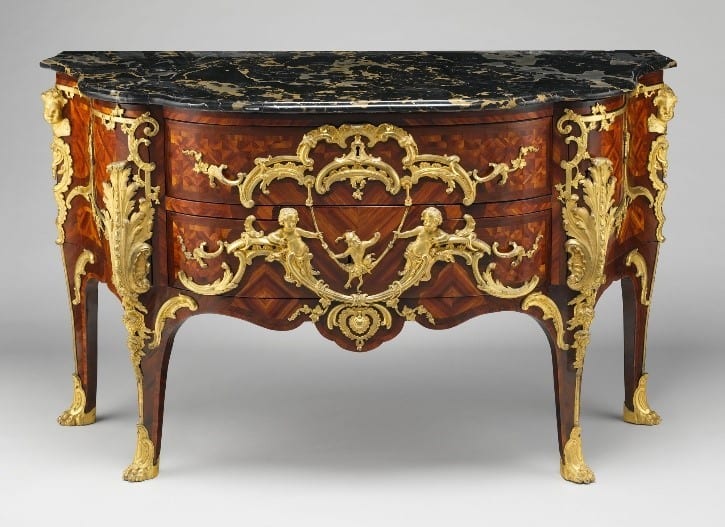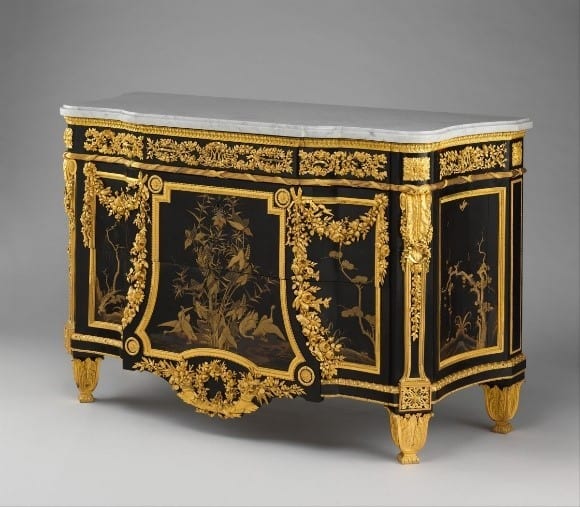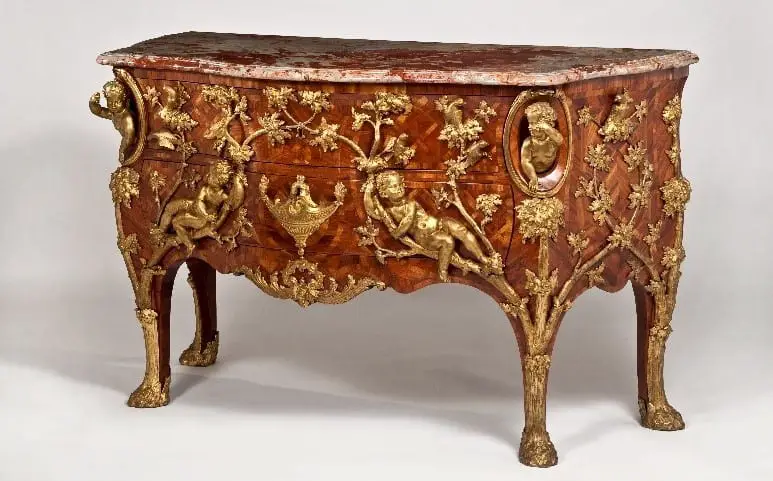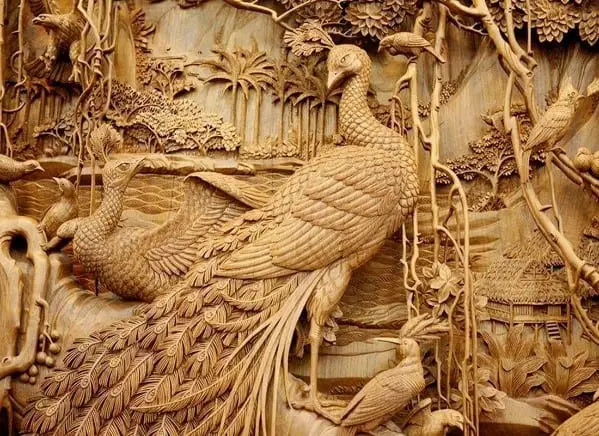
Back in the 18th century, the French art of cabinet-making was flourishing. Thus, various “objets d’art” (art objects) were produced following strict regulations. Ultimately, the luxurious style of 18th-century Paris furniture was intricately connected with the talented masters of cabinet making – Ébénistes.
Ébéniste is actually the French word for cabinet-makers.
Thus, ébénistes would be solely involved in the process of creating case furniture. Even though the ébénistes were generally a part of the woodworking industry, their obligations had nothing to do with the obligations of joiners or carvers, for example.
Above all, the strict separation between the guilds was cleverly applied because of the fact sawdust was the worst enemy of freshly veneered masterpieces.
By monitoring the artisans and controlling the process of ébénisterie in separate workshops, the art of French cabinet-making reached exceptional levels of exquisiteness.
Understanding the Parisian Guild Regulations

The Parisian Guild Regulations of the 18th century were unique. The efforts of the French government were focused on creating jobs for as many different artisans as possible. Thus, each of the gifted craftsmen who worked as part of the furniture industry had a very specific role in the process of woodworking.
To illustrate this better, cabinet-makers would stick to making cabinets and they would not interfere with any other aspect of the workflow.
For the purpose of separating the roles in the furniture industry, as well as to regulate the work process better, the French government required that each artisan would use a particular stamp.
By stamping furniture, the craftsmen would take full responsibility for their part of the making process, and would also indicate the artist behind the specific piece of furniture.

As a result of the stamped furniture French regulations, furniture making in 18th-century Paris turned into a form of art rather than merely an anonymous process.
Ébénistes, Menuisiers & Marchands-merciers

Ébénistes, menuisiers, andmarchands-merciers are three different titles that were used to define the process of furniture making by specifying the roles of each craftsman in the work process.
Ébéniste
The very word ébéniste originates from theword“ebony.”
Interestingly, ebony was the most favored type of wood for the making of cabinets in mid-seventeenth Paris. On another note, there is also an English equivalent of the word “ébéniste” – “ebonist.”

Ebony was the perfect and most favored material for the production of luxurious French furniture that was a reserved territory of the elite. That’s because ebony possesses an incredibly fine texture.
Thus, once polished, ebony becomes silky smooth, and that quality makes it amazing when it comes to ornamental wood use. In fact, the ancient Egyptians have also recognized the beauty of ebony and various ebony-carved pieces were foundin tombs.
It was in 1751 when the French parliament passed a rule that obliged all cabinet-makers to stamp their creations. The stamp was granted by the respective guilds. Most noteworthy, the valuable stamp indicated that the artisans were officially allowed to practice their craft.
Menuisier
On another note, the title menuisier was used to describe the position of a French woodcarver (or royal chair maker).

It wasn’t before the mid-nineteenth century that both the term for ébéniste, as well as the term for menuisier were sheltered under the same roof.
Most importantly, the transition was possible because of the birth of the French furniture making industry that gradually began to become more popular than the artisan crafts of the 18-th century Paris. Thus, little by little, the separation between the guilds started to disappear.
Marchand-mercier
A marchand-mercier had a very specific role in the development of the French craft of furniture making.
In fact, experts believe that the French furniture industry would have not become so advanced in such a short period of time if it wasn’t for marchands-merciers who were the 18-th century Parisian “propagators of taste.”
In short, marchands-merciers were the negotiators who connected the craftsmen’ services with the elite.
But moreover, marchands-merciers did not only negotiate with clients from the royal and aristocratic courts. Instead, the marchands-merciers were monopolists with great power for they had access to rare luxurious materials such as porcelain, for example.

Thus, marchands-merciers would combine the art of excellent communication and selling skills with the artistic talent of crafting unique objects for that time.
For instance, they would fuse the exoticness of lacquer screens by adding these into pieces of furniture.
Doing so greatly increased the value of the goods, subsequently increasing the interest, and of course, the number of orders, which, in return, highly influenced the work of both menuisiers and ébénistes.
Top 3 Famous Masters of ébénisterie

The traditional Parisian ébénisterie which translates into cabinet-work flourished through the 17th and 18th century. The French Revolution in 1791 greatly affected the guilds. In fact, soon after the end of the revolution many of the former guilds were abolished.
However, the sparkling trace of the talented ébénistes managed to expand beyond the territory of France. As a result, a great number of ébénistes from German origin came to practice the noble craft in Paris. Nevertheless, a number of ébénistes also came to practice the French craft after leaving the Low Countries.
Louis XIV’s Favorite Ébéniste: André-Charles Boulle

André-Charles Boulle was born in Paris, France on November 11, 1642. Boulle has left an incredible legacy for generations to come. In fact, his work as a royal ébéniste was so highly valued, that his name has turned into a byword for French cabinetmaker.
Amazingly, André-Charles Boulle’s style was so inspiring that years after his death in 1732, various craftsmen from all over Europe continued to imitate his work. To be more specific, it was the “boulle” style that lingered through the veils of time, making artisans from the 18th and 19th century to try to mimic the fashionable inlaying of the famous Parisian ébéniste.
The spectacular talent of André-Charles Boulle was noticed by Loius XIV, widely known as the Sun King. The Sun King was so deeply in love with Boulle’s style and skills, that he granted the craftsman unique and special privileges. As a result of the King’s will, Boulle’s work was not controlled by the guilds.
Apart from avoiding the strict regulations of the time, the Sun King allowed Boulle to open several workshops in the Louvre. Because of the fact Boulle had close control over each aspect of the cabinet-making process, he managed to develop and apply a stunningly harmonious, holistic style.
One of Boulle’s hallmarks was the implementation of the marquetry technique. Instead of following the marquetry trends of the 16th century, Boulle incorporated exotic woods. For instance, he would opt for South American woods, as well as woods ordered from India.
Occasionally, Boulle would also engrave the beautifully elaborate brass adornments. All in all, most of the furniture in the legendary Versailles palace was born by Boulle’s skillful hands, vivid imagination, and absolute dedication to the ébénisterie craft.
The Gifted Ébéniste Rulebreaker: Charles Cressent

Charles Cressent was born in France in 1685 but it wasn’t before 1719 that he was officially proclaimed a master ébéniste. Nonetheless, he was also acknowledged for his talent as a sculptor. In fact, Cressent came from a family of sculptors so it would be fair to say that art was already flowing in his veins from a very young age.
Ultimately, Charles Cressent’s name and artistic career are closely related to the duc d’Orléans – Regent, Philippe II.
One of Cressent’s hallmarks was the gilt bronze mounts that were highly sculptural, turning each piece of furniture into a spectacular form of art. On another note, his favorite veneers included those made out of amaranth and satinwood.
Ironically, the notorious guilt bronze mounts became the very reason that jeopardized Cressent’s career.
Charles Cressent wanted to ensure the highest quality of the fine bronze mounts, and that’s why he hired master gilders, as well as master casters in his workshops. However, this decision counterfeited the strict Parisian guild regulations.
As a result, the French government prosecuted Cressent for practicing two professions in the same workshop. Moreover, Cressent was fined and the only way to pay the fees was to sell his stock.
On another note, Charles Cressent’s furniture was also unsigned, unlike the neatly stamped furniture of other craftsmen of the time.
Thankfully, Cressent created catalogues that introduced important evidence for the connoisseurs who wanted to distinguish his unique works of art.
Charles Cressent passed away in 1768, re-known as the next most famous ébénisterie master, right after the legendary Boulle.
The Favorite Ébéniste of Marie-Antoinette: Jean-Henri Riesener

Jean-Henri Riesener is a beautiful example of the masters of ébénisterie who were not born or raised in France.
Johann Heinrich Riesener was actually born in Gladbeck, Germany. Soon after he moved to Paris, he became an apprentice with Jean-Francois Oeben in 1754.
14 years of apprenticeship passed before Riesener was officially proclaimed master ébéniste in 1768.
However, Riesener’s hard work and amazing talent were soon to bring him the title of “the greatest Parisian ébéniste of the Louis XVI period,” or “ébéniste ordinaire du roi.”
Interestingly, it was only a single year after Riesener received his title as a master ébéniste that he completed one of his most legendary pieces of work – the roll top cylinder bureau ordered for King Louis XV.
In fact, the making of King Louis XV’s bureau was first commissioned to Riesener’s mentor (and father-in-law), Jean-Francois Oeben in 1760. The amazing bureau that was bound to become a part of the King’s private cabinet was not only beautiful but also extremely innovative.
Thanks to the ingenious locking mechanism, the King’s bureau could be opened with a single press of a button. What’s more, it was locked with a single turn of a key, and that was extraordinary for the time.
Nevertheless, the exquisite bronze work, as well as the high quality of the marquetry turned the King’s new bureau into a trampoline of Reisener’s glorious ébéniste career path.
After the creation of King Louis XV’s roll top cylinder bureau, orders for more of Reisener’s incredible masterpieces literally started flooding from the Court. This process continued for some good 10 years, and during this period Reisener also became the favorite ébéniste of Marrie Antoinette.
Ironically, Marrie Antoinette remained one of the few loyal customers of Reisener.
The high prices Reisener asked for his pieces of furniture made many of his former clients run towards his competition. As a result, Reisener’s comrade – Beneman, started working on many of the orders at much more reasonable prices.
The hallmarks of Reisener’s work were the finely chases mounts and the pictorial marquetry.
A Tribute to Ébéniste: The Bottom Line

The incredible pieces of furniture created by the gifted ébéniste masters can hardly ever get out of date. Furthermore, experts believe that the value of original antique ébénist furniture will keep rising in the following decades.
However, according to a recent estimation by Will Strafford, who is a Senior International Specialist for European Furniture and Works of Art, 2018 is a great time to invest in the art of ébénisterie.
Finally, we hope that our tribute to ébéniste has enriched your day with valuable and little-known facts straight from the heart of 17-th and 18-th century Paris. Because just like the French proverb goes – C’est la vie! – That’s life! – and what is life without art?






